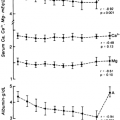ENDOMETRIOSIS
Robert L. Barbieri
Endometriosis is the presence of endometrial glands and/or stroma outside the uterus. The most common sites of endometriosis lesions are the pelvic peritoneum, ovary, uterosacral ligaments, bladder, bowel, and appendix.1 Endometriosis is present in ˜5% of women of reproductive age. Although it is a common disorder, it is an enigmatic disease that can be difficult to diagnose. There is a mean interval of 4 years from initial presentation to a physician with a symptom of endometriosis until the definitive diagnosis of the disease.
Most women with endometriosis have pelvic pain, infertility, and/or an endometrioma (an ovarian endometriosis cyst). Pelvic pain caused by endometriosis lesions is best treated by suppression of ovarian estrogen production; infertility caused by endometriosis lesions is best treated by surgical resection of the endometriosis lesions, empirical stimulation of multifollicular development with clomiphene, administration of exogenous gonadotropins to increase fecundability, or in vitro fertilization (IVF). Nonfunctional cysts of the ovary, such as an endometrioma, are best treated by surgical removal. Surgical removal of nonfunctional ovarian cysts is both diagnostic and therapeutic. The likelihood of recurrence of an endometrioma is <10%.2
Stay updated, free articles. Join our Telegram channel

Full access? Get Clinical Tree





